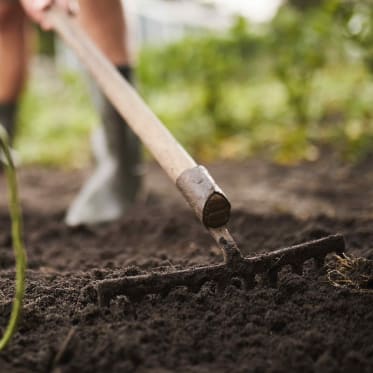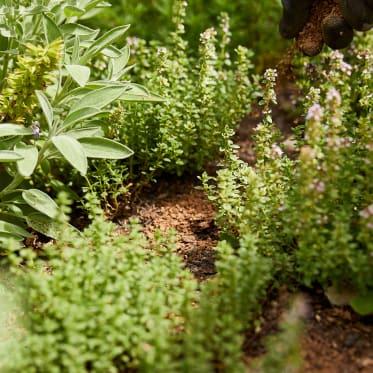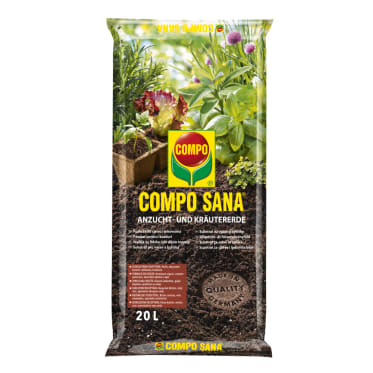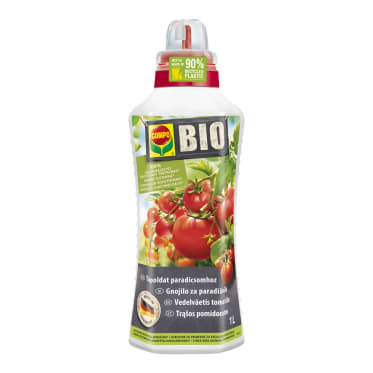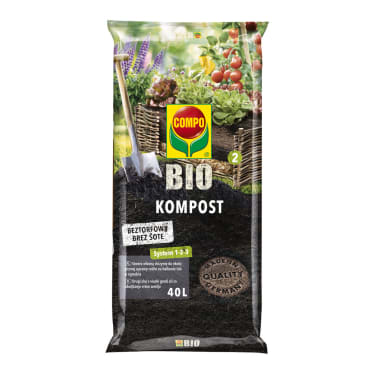Frequent search terms
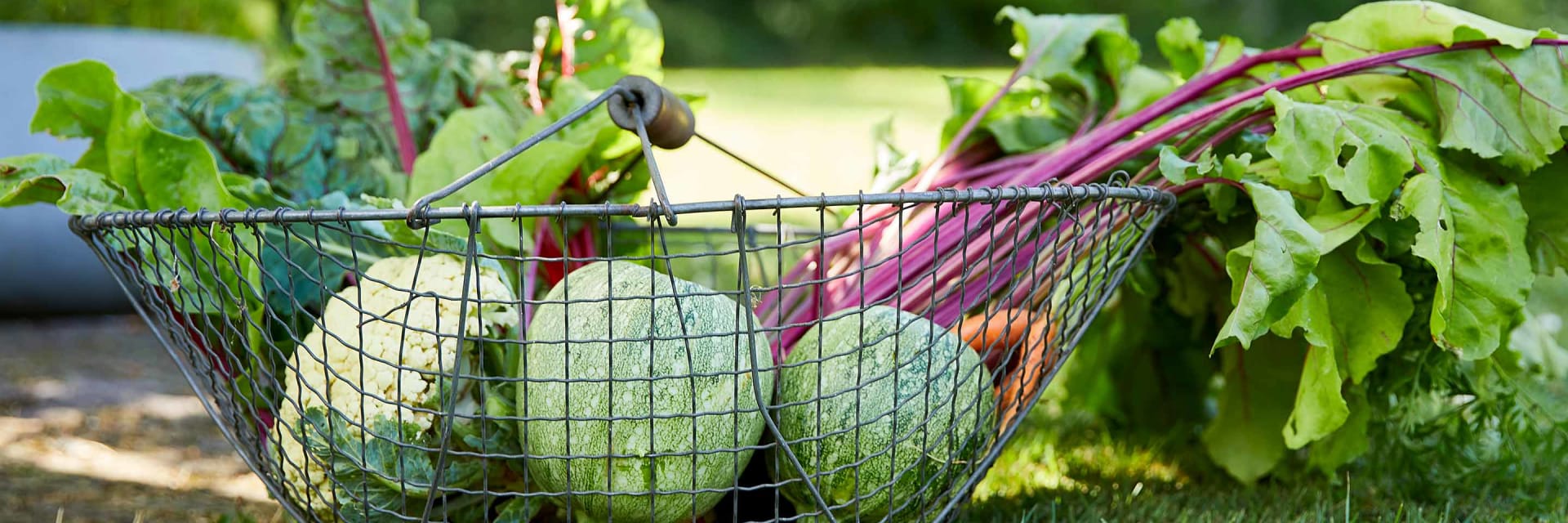
- COMPO
- Guide
- Plant Care
- Herbs, fruits and vegetables
- Growing vegetables without a green thumb – nine tips
Key tips for planting vegetables
Growing vegetables without a green thumb– nine tips
Courgettes, fresh Swiss chard, a large cauliflower, carrots and some soil-dusted beetroots – the first summer stroll through the vegetable patch starts with great promise indeed. If you think, "oh well, I'd like to plant some vegetables but it's probably such hard work", just keep reading. We'll show you how simple and straightforward it is to grow vegetables!
Table of content
If you've never grown vegetables before, the first step is often the scariest. Ultimately, you often don't know where to start. When can you start planting tomatoes? How much space does kohlrabi need? Can you sow cucumbers directly outdoors? We want to help shed some light on the subject. In this guide, you'll find the nine key tips for growing vegetables – no prior knowledge or experience is required, just a bit of dedication and a love of gardening.
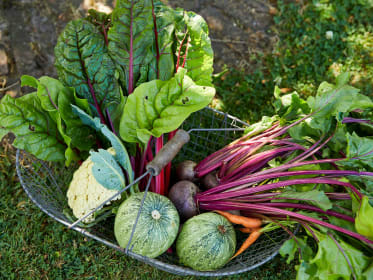
1. Start small
Instead of a big vegetable garden with mixed cultivation and four-field rotation, we recommend starting with a small patch. This gives you a good overview of your vegetable plants. To do this, clear a small area outdoors for your vegetables to grow in. Ideally, put it near your house, so you can keep a better eye on your plants and intervene if you spot pests or other problems. Alternatively, you can also set up a raised bed. If you have a large outdoor raised bed, you can plant almost the same vegetables there that you could in a vegetable patch.
There are even mini raised beds for small patios or balconies. Mini raised beds are perfect for lettuces, radishes, tomato bushes or peppers.
That said, you can also grow your vegetables in boxes or containers. There are no limits on your creativity here. Just remember that some plants can get really quite big as time goes on – but more on that later.

2. Begin with beginner plants
The type of vegetable that you plant does actually make a difference. There are some vegetables that are harder to care for and need a longer time to ripen, while others grow quickly and even form fruits under tricky conditions. For instance, these latter vegetables include radishes, carrots, sugar-snaps, lettuces like head lettuce, lamb's lettuce, romaine and various herbs. Simply sow these plants and harvest them a few weeks later.
These low-maintenance vegetables are perfect for beginners with no prior experience. After your initial successes, you can opt for trickier candidates
There are two other key aspects to bear in mind when choosing vegetable plants. We'll explore them now.

Sow vegetables or plant them?
Some vegetables are best sowed straight into a patch. They include lots of root vegetables like radishes, parsnips and carrots.
Plants like curled lettuce, rocket, beetroot, rosemary, chives or peas can either be sowed directly into a patch or bought as seedlings and planted out. In this case, you can decide for yourself whether you want to sow them as seeds or opt for seedlings.
For fruiting vegetables like tomatoes, cucumbers, aubergines, pumpkins or peppers, we recommend starting by buying young seedlings. If you're interested, you can sow the vegetables yourself, though. However, you don't germinate them in a patch: use little seed containers on your windowsill or a heated greenhouse instead. You need to pre-germinate the vegetables here until they can go outside in mid-May.

When can you get started?
Not every plant can be sown or planted at the same time. Some kinds, like radishes, peas and carrots, can be sown from mid-March if the weather is fine. Others, such as dwarf French beans or climbing French beans, need a warm house to germinate. Plus, there are differences between individual varieties. So, make sure to follow the information on the seed package.
Generally, you can sow most root and leaf vegetables from April onwards. By then the sun's stronger and the weather slightly kinder.
This rule doesn't apply to varieties that are very sensitive to frost, however. This primarily refers to fruiting vegetables like tomatoes, cucumbers, peppers, aubergines, chillies, courgettes and pumpkins. As late frosts remain a risk until mid-May, you should avoid planting frost-sensitive vegetables until after this point.
Ten easy vegetables for beginners
|
Vegetable |
Sow or plant |
Sowing/planting period |
|
1. Radishes |
Sow directly into the patch |
Sowing period: from mid-March |
|
2. Carrots |
Sow directly into the patch |
Sowing period: from mid-March |
|
3. Curled lettuce |
Sow directly into the patch/plant in the patch as a seedling |
Sowing/planting period: from mid-March |
|
4. Peas |
Sow directly into the patch/plant in the patch as a seedling |
Sowing/planting period: from mid-March |
|
5. Swiss chard |
Sow directly into the patch/plant in the patch as a seedling |
Sowing/planting period: from April |
|
6. Kohlrabi |
Sow directly into the patch/plant in the patch as a seedling |
Sowing/planting period: from April |
|
7. Beetroot |
Sow directly into the patch/plant in the patch as a seedling |
Sowing/planting period: from April |
|
8. Tomatoes |
Plant into the vegetable patch as a seedling |
Planting period: from mid-May |
|
9. Chillies |
Plant into the vegetable patch as a seedling |
Planting period: from mid-May |
|
10. Courgettes |
Plant into the vegetable patch as a seedling |
Planting period: from mid-May |
3. Choose the right spot
If the conditions aren't right, you won't get an abundant harvest of vegetables. So, make sure to choose a good spot. As most vegetable plants love the sun, you're best off choosing a location that's sunny or half-shaded, at most. Some plants, like tomatoes, cucumbers or peppers, particularly like to be protected from rain. If you've not got a covered area, we'd suggest opting for a hardy outdoor tomato variety. In general, you can sow most vegetables outdoors, on your balcony or in your greenhouse.

4. Leave some room
Most garden centres or nurseries are home to an array of young seedlings. At first glance, they look so small that you'd think they'd easily fit in a pretty container. But they take up more and more volume as the summer goes on so they can form their fruits. Tiny tomato plants become huge shrubs stretching two metres tall, for instance. As a result, it's important to check the label in the pot before you make a purchase. This contains all the important information about the variety, including how tall it can grow.
Generally speaking, courgettes and pumpkins need a good square metre of space. Depending on the variety, tomatoes can grow between 30 cm and 250 cm tall. Even small radishes need sufficient space between them: if all your radish seeds are tightly packed, the radishes prevent each other from growing, so they can't form their round tubers. If you're sowing vegetables in rows, it's worth leaving a bit of space in between each so you can care for and harvest the vegetables more easily, too. So, plan sufficient space in the patch so every plant has room to develop.
If you're growing vegetables in a container, you should also bear in mind that containers usually offer less space for the plant's roots than a garden patch. Ensure your container is the right size. The container for a large stake tomato should be at least 20 litres, while a courgette would benefit from at least 40 litres of space. Radishes and lettuces can be grown easily on balconies.
Vegetables that stay small are ideal for mini raised beds, such as dwarf tomato bushes, mini pepper plants, radishes, carrots or lettuces. Here, too, make sure to leave a bit of space between the plants.
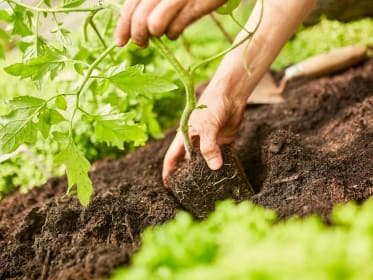
5. Laying the ideal foundations for vegetables.
Outdoors
Alongside choosing the right location, it's important to lay good foundations for healthy growth. Most vegetables can be planted easily in a loose, humus-rich garden soil. Rake over the vegetable patch well before you plant them and remove any weeds so they don't get in the way of your freshly planted vegetables. Lots of vegetables would be happy if you worked some garden compost into the soil. The compost creates a good soil structure and is gradually turned into nutrients by microorganisms.
If you want to plant heavy or medium-feeding vegetables like tomatoes, cucumbers, peppers, pumpkins or courgettes, we recommend working a special slow-release fertiliser for vegetables into the soil. This ensures the vegetables have sufficient nutrients over the next few weeks – which are indispensable for growth and fruit formation.
You might be wondering what 'heavy-feeding' means? In simple terms, heavy-feeders need lots of nutrients, while light-feeders, like radishes, lamb's lettuce or peas, need much fewer. Carrots, kohlrabi and Swiss chard are in the middle.
Tip: If your soil is heavy and damp, you should work in some sand and humus before planting. This loosens up the soil and ensures water can drain better. Generally, if you have heavy or sandy soil, it's easier to put the vegetables straight into a raised bed or various containers.

In raised beds or containers
We recommend our raised bed and vegetable soil if you want a colourful array of vegetables in your raised bed. It's suitable for all kinds of vegetables and perfect for taking your first step into the world of growing your own.
If you want to grow your vegetables in a container, you can take a slightly more nuanced approach: for heavy-feeders like tomatoes, peppers, courgettes, or broccoli, you can use a particularly nutrient-dense soil like 'COMPO BIO Potting Soil for Tomatoes and vegetables' organic peat-free soil for tomatoes and vegetables. If you're only sowing light-feeders, we recommend using a special seed compost.
Tip: Alongside choosing the right soil, good drainage is also recommended. Good drainage ensures that excess rainwater or water from watering can flow off easily. This prevents standing water and stops roots from rotting.
To create good drainage in a container, you can simply put a layer of sustainable pumice granules on the bottom of the plant pot. Plus, the container needs to have drainage holes so the water can run off.

6. Good planting is half the harvest
It's time! You've chosen the perfect spot, left enough space, picked the right soil – now you can get started!
Planting vegetables – in three steps:
- Dig a small hole and position the seedling within it. For tomatoes, courgettes and similar vegetables, it's worth also working some 'COMPO BIO Universal Longterm Fertilizer with Sheep Wool' organic slow-release fertiliser with sheep's wool into the soil before you plant. This supplies the vegetables with a wide range of nutrients for up to five months.
Tip: If the root ball is very dry, you can dip it into a container of water or water it before you plant it. - Fill the gaps with soil and press everything in firmly.
- Now water the plants. This makes it easier for them to take root.
Sowing vegetable seeds – in three steps:
- If you want to sow radishes or spinach in rows, for instance, create a furrow one or two centimetres deep before you sow. If the soil is really dry, you can give it a good soaking of water beforehand.
- Cover the seeds with soil. In general, the layer of soil needs to be twice as deep as the height of the seeds.
- Water the seeds, ideally using a watering can with a rose. Plus, the seeds would appreciate being kept damp over the next few days or weeks. Only when they start to sprout can you reduce your watering.

7. Test with your finger before watering
'Water regularly', 'water as required' – how often we read these instructions and then wonder what they actually mean: does 'regularly' mean daily, once a fortnight or even once a month? The key thing to remember is that there is no one-size-fits-all rule. The amount of water needed is dependent on a wide range of different factors. Is the plant in a container or a patch? Is it very warm and sunny or has it just rained? Is it a heavy, damp substrate or is the soil actually light and sandy?
So, the easiest tip: only pick up your watering can once the top layer of soil has dried out. Don't water if the soil still feels damp. However, don't let the root ball dry out, either. Ideally, poke your finger two or three centimetres deep into the soil and see how damp the soil is. This finger test gives you a sense of how thirsty your plants are.
Three more key tips:
- The best time to water is in the early morning or evening.
- Pour the water straight onto the soil, not over the plant's leaves and flowers. Otherwise, you can end up with unsightly infections, such as fungal pathogens.
- Remove any excess water from the saucer to prevent the roots from rotting.

8. Fertilise! Vegetables are hungry
While you cook yourself a lovely dinner, you forget that plants get hungry and need nutrients, too. Nitrogen, potassium and phosphorus are particularly crucial. If plants don't get enough nutrients, they'll suffer from a deficiency. This expresses itself in various ways, such as distorted growth, yellow leaves, puny flowers, fewer fruits. As a result, you need to fertilise your plants regularly with a liquid fertiliser designed for vegetables. You can easily add this to your watering can and water the plants with it. Heavy-feeders like tomatoes, courgettes or peppers need substantially more fertiliser than light-feeders. So, read the dosing instructions on the packaging before fertilising.

9. Suck it and see
For some, taking their first steps with growing vegetables means going to a garden centre to discover all the plants on offer and getting started from there. For others, it means learning everything they can about which plants are good to position next to each other and the ideal rotation strategy, with main crops and late crops. Ultimately, if you just want to get started and grow some tomatoes, then do it! After all, gardening should be fun – and often it's easier to learn something by trying it out in practice, rather than just reading theory. However, if you're keen to explore vegetable-growing a bit more, we've got some in-depth tips for you below.
No matter whether you now want to get cracking with sowing your vegetables or you want to keep reading, we wish you every joy and success!
More tips for your vegetable garden
Suitable products for growing vegetables

